What Are the Different Types of Keywords?
The different types of keywords are informational, navigational, commercial, and transactional.
That’s if you categorize your keywords based on the type of search intent—i.e., the general purpose behind the user’s search:
- Informational: Searchers want to find information
- Navigational: Searchers want to find a specific site or page
- Commercial: Searchers want to investigate brands, products, or services
- Transactional: Searchers want to complete an action (e.g., make a purchase)
There are other keyword categories used in SEO. For example, local keywords are used to find nearby products or services. And long-tail keywords are highly specific search terms.
But analyzing keywords based on intent can be particularly helpful. Because it helps you understand how to compete on search engine results pages (SERPs).
The intent type assigned to a keyword can tell you if a searcher is looking to buy something soon, shop around, or gather information.
Let’s look at each of the search intent categories in more detail.
1. Informational
Informational keywords are search queries used by people who want to learn something.
Here are some informational keyword examples:
- Coffee calories
- National coffee day
- What is the difference between cold brew and iced coffee
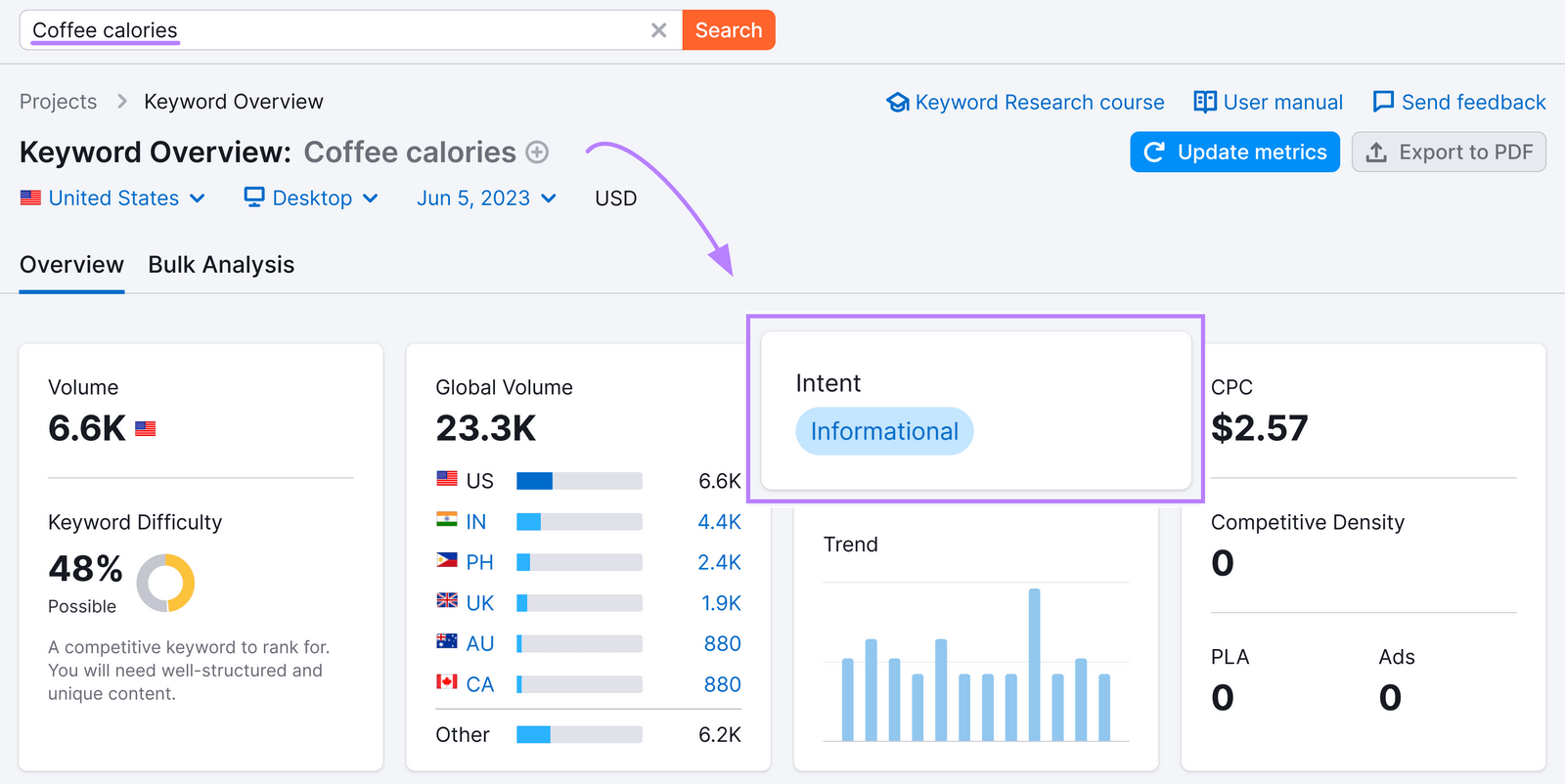
Informational keywords frequently (but don’t always) take the form of question keywords. This means they often start with “what,” “why,” “how,” and so on.
Google’s results for informational searches commonly contain featured snippets, which provide searchers with quick answers.
For example, here’s the featured snippet for the informational keyword “what is the difference between cold brew and iced coffee”:
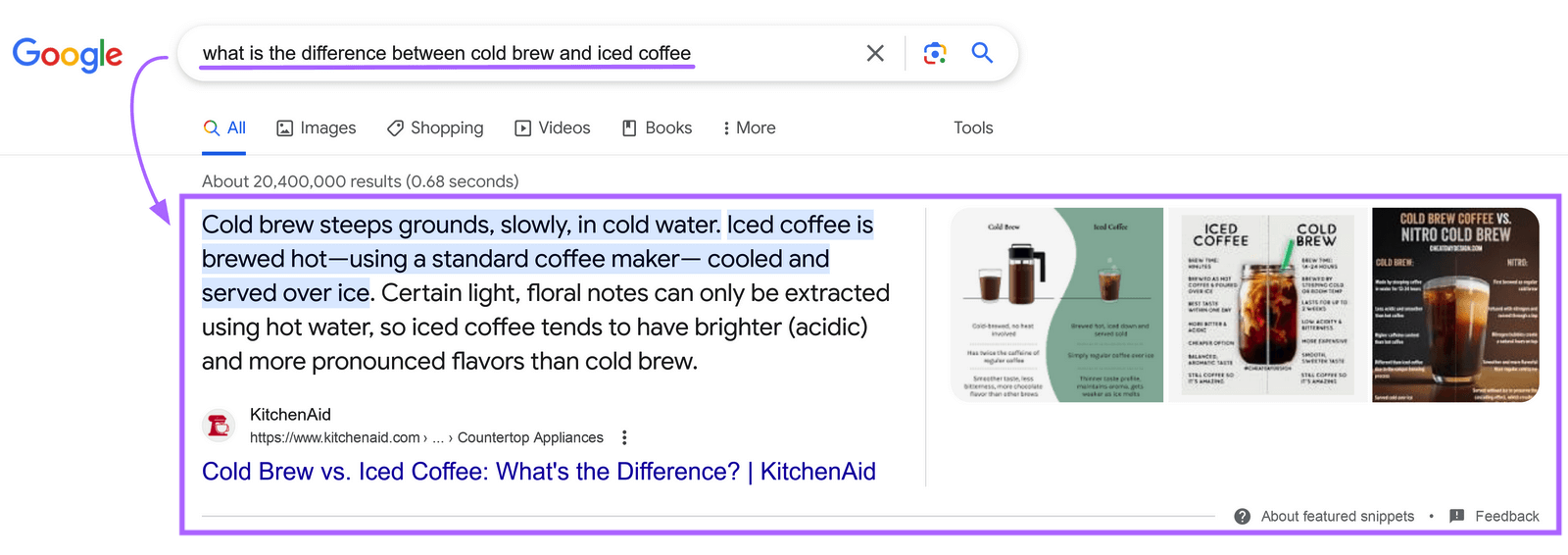
Informational keywords are usually higher in the marketing funnel. This means that people are earlier in their buying journeys. And less likely to take action (e.g., make a purchase).
As a result, informational content tends to have a lower conversion rate. But it can help you build brand awareness. And become an authority in your niche.
2. Navigational
Searchers use navigational keywords to find a specific site or page.
When someone types a website or brand name into a search engine, they perform a navigational search.
Here are some navigational keyword examples:
- Youtube
- Semrush blog
- Where is angelino’s coffee located
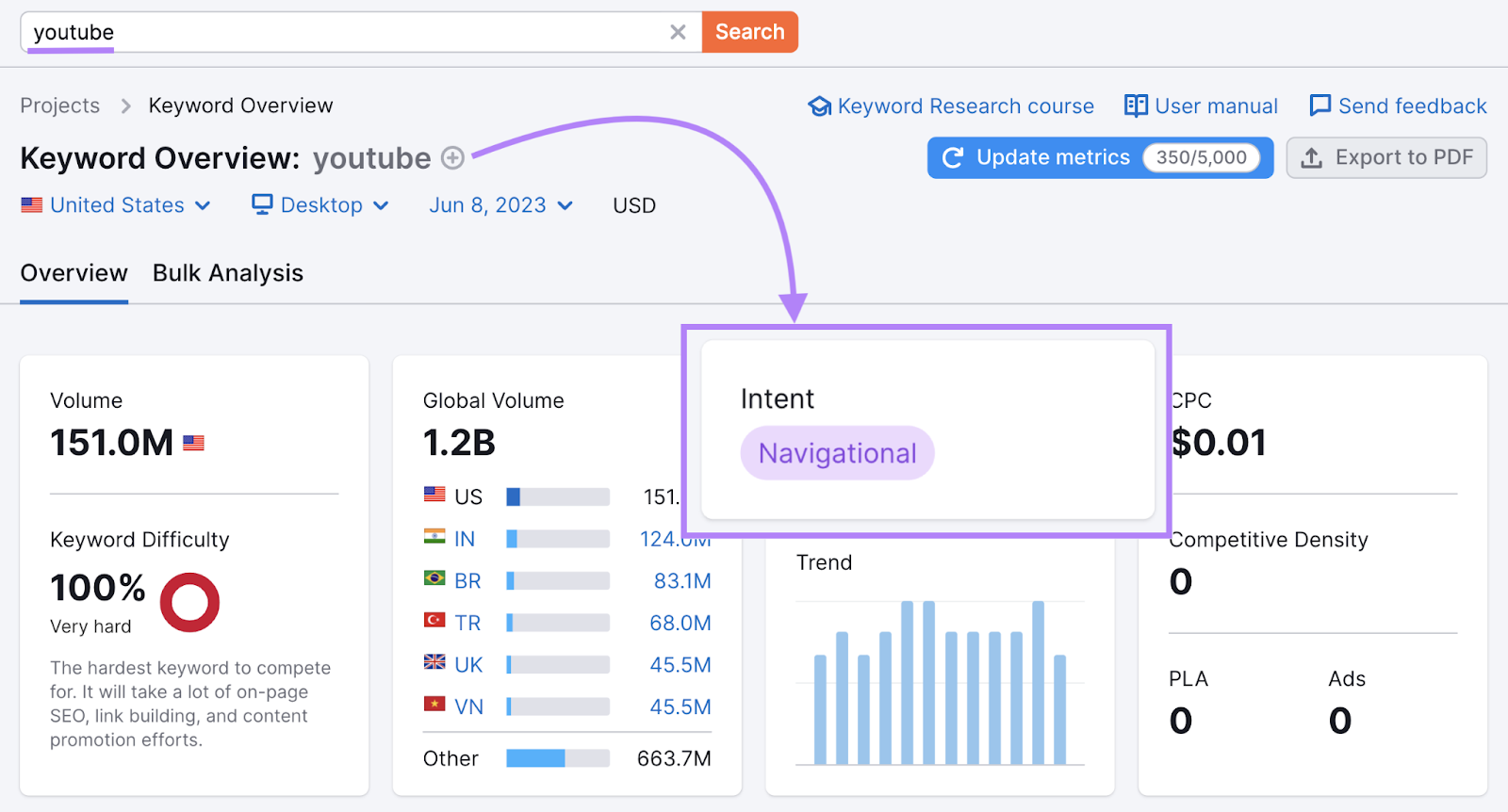
People behind these searches already know the company or product. And want to find the correct website or physical location to get to their products or services.
These keywords can be helpful sources of organic traffic when the brand or the site are well-known and popular.
You should naturally rank highly for keywords that contain your brand name.
3. Commercial
People use commercial keywords to research specific brands, products, or services. They may want to check reviews, compare products, or look for discounts.
You can target these keywords with comparison articles, listicles, reviews, or how-to articles. Depending on the specific keyword.
Here are some commercial keyword examples:
- Free coffee
- Dunkin iced coffee flavors
- Peet’s coldbrew vs starbucks coldbrew
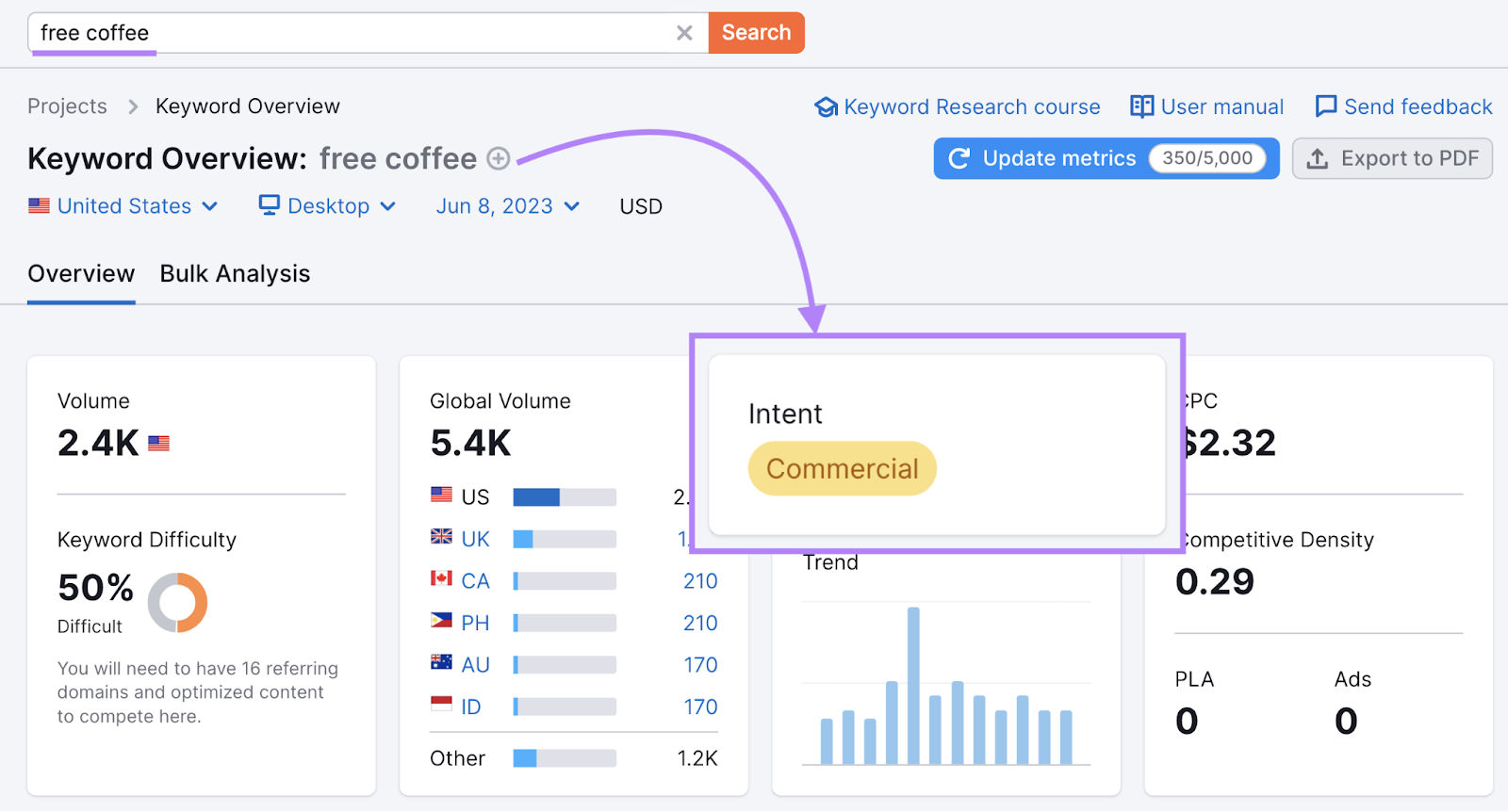
These keywords reveal a person’s intention to buy or take some form of commercial activity in the future. So they can help you to reach high-quality prospects.
4. Transactional
Transactional keywords are the keywords that show the strongest intent to buy or take imminent action.
These keywords can be targeted with paid ads and highly optimized product pages. Or other landing pages where users can take immediate action on a site.
Here are some transactional keyword examples:
- Buy crypto online
- Sandwich places near me that deliver
- Pickup truck for sale
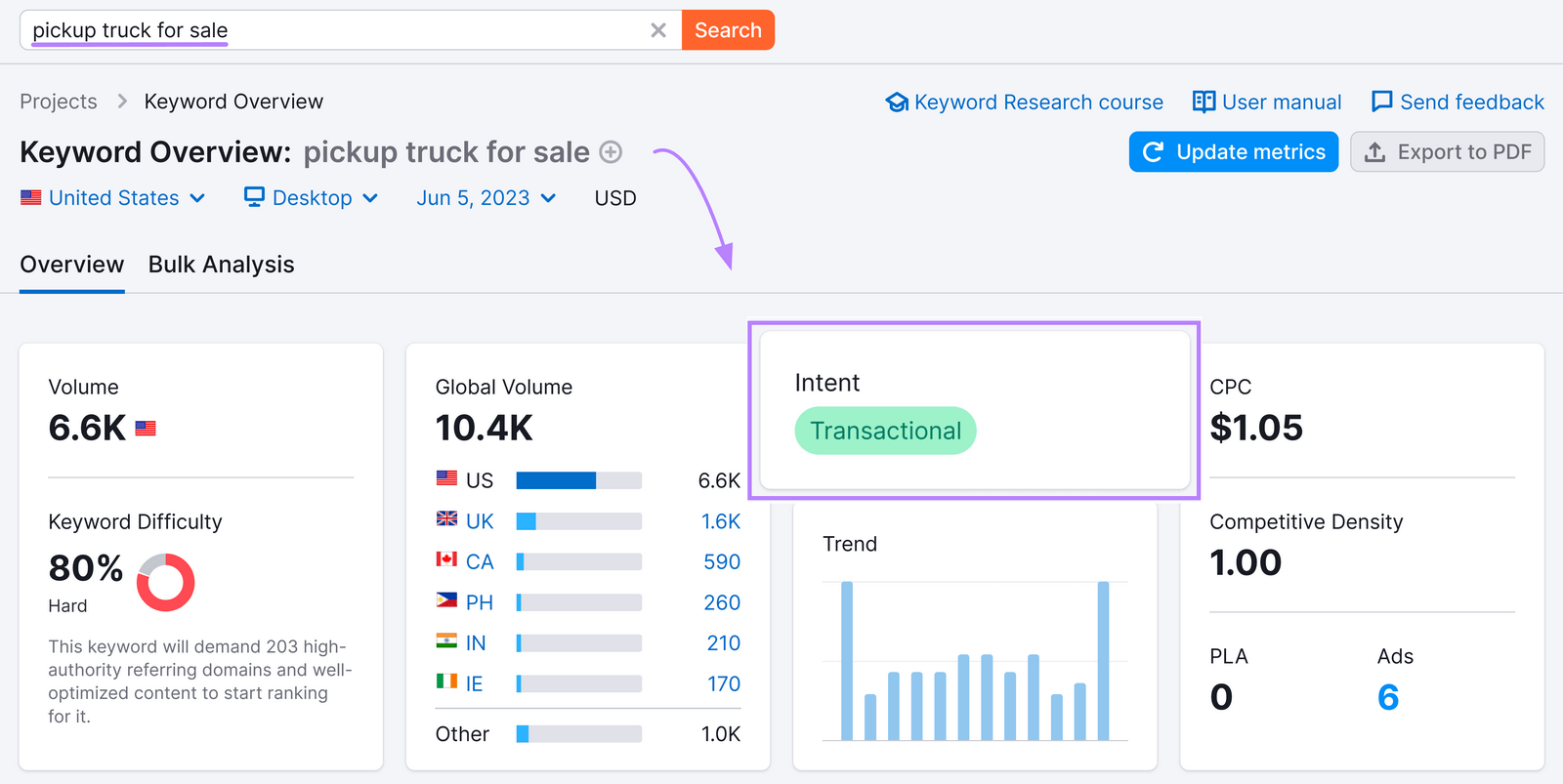
These searches can happen after someone has already searched for information, made a decision, and is determined to now take a specific action or make a purchase.
Transactional keywords often feature words like “buy,” “subscribe,” “for sale.” So, their SERPs often have Google Shopping Ads.
Like these:
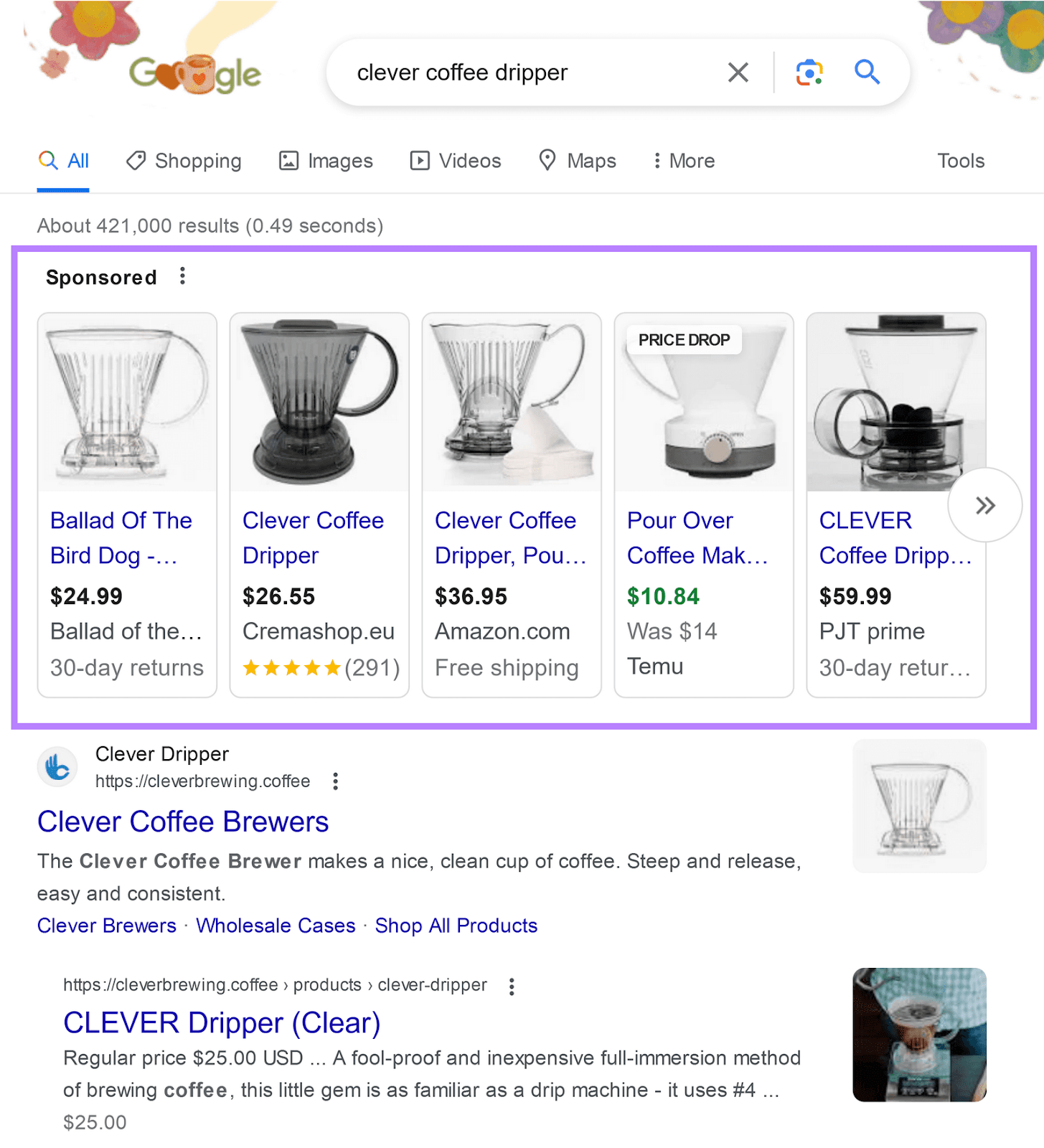
Transactional keywords can also be called buyer keywords because they’re most likely to be used by a person at the bottom of the buying funnel. That means these keywords are highly valuable when doing keyword research and planning an SEO or PPC strategy.
As a general rule, transactional keywords describe a product or service more precisely (“neon blue unisex watch,” for example). More general keywords (e.g., “men’s watches”) fit into the commercial category.
How to Check the Type of Keyword Intent
The intent behind different keywords isn’t always obvious.
For example, are most people searching “apple” looking for information about the fruit? Or trying to navigate to the technology brand’s website?
One way to understand search intent is to analyze the SERPs to see what type(s) of results Google displays.
Here, we can see that Google predominantly ranks information about the brand. So “apple” is a navigational search in the U.S.
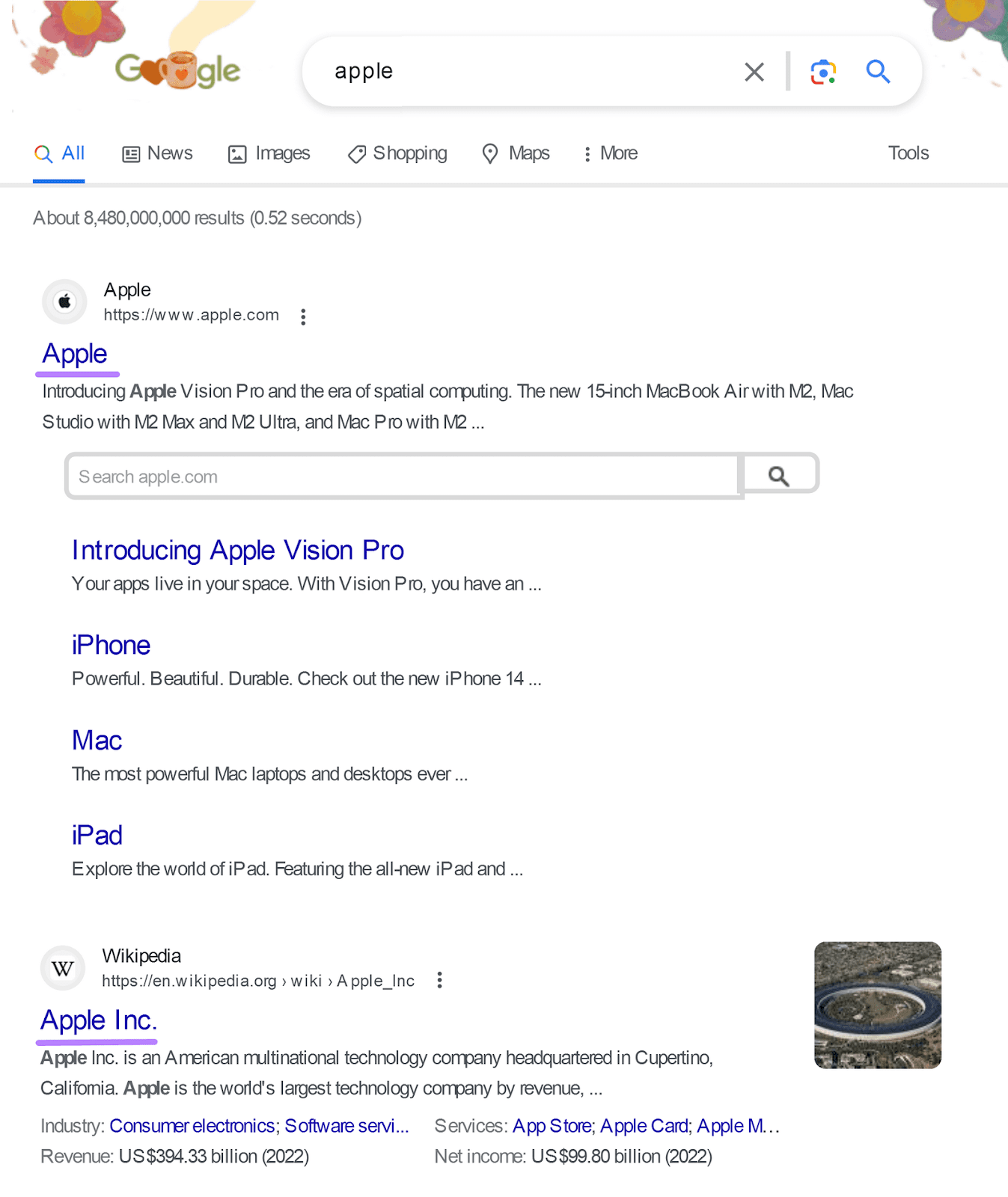
Some keywords have mixed intent. Meaning that there’s a strong divide between the results searchers want.
For example, the first page of Google’s results for “coffee beans” provides commercial and informational results.
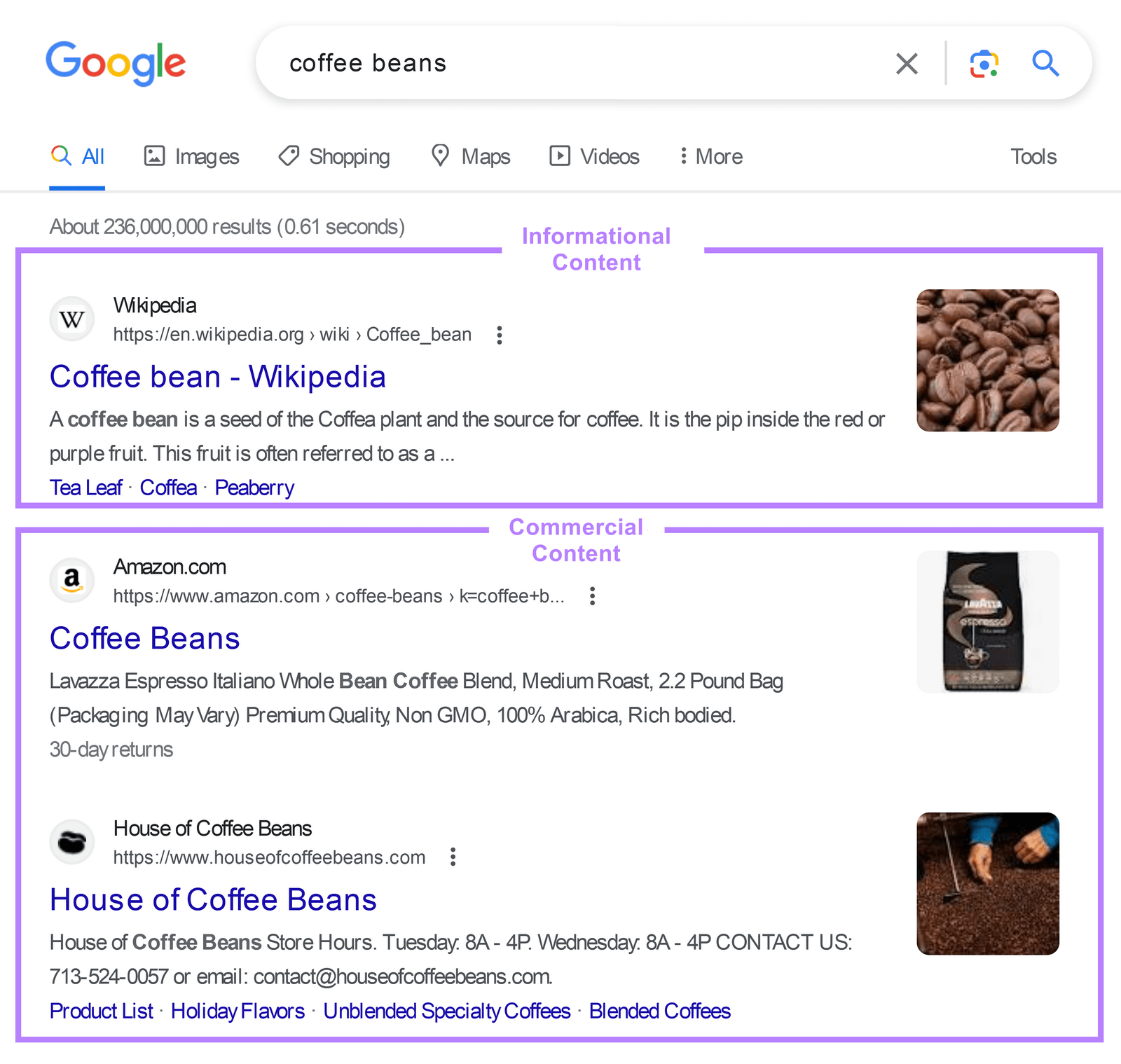
With Semrush, you can quickly reference the type of search intent keywords have.
All you have to do is look for the “Intent” box or column in any keyword-related report.
The intent type might be abbreviated like so:
- I = Informational
- N = Navigational
- C = Commercial
- T = Transactional
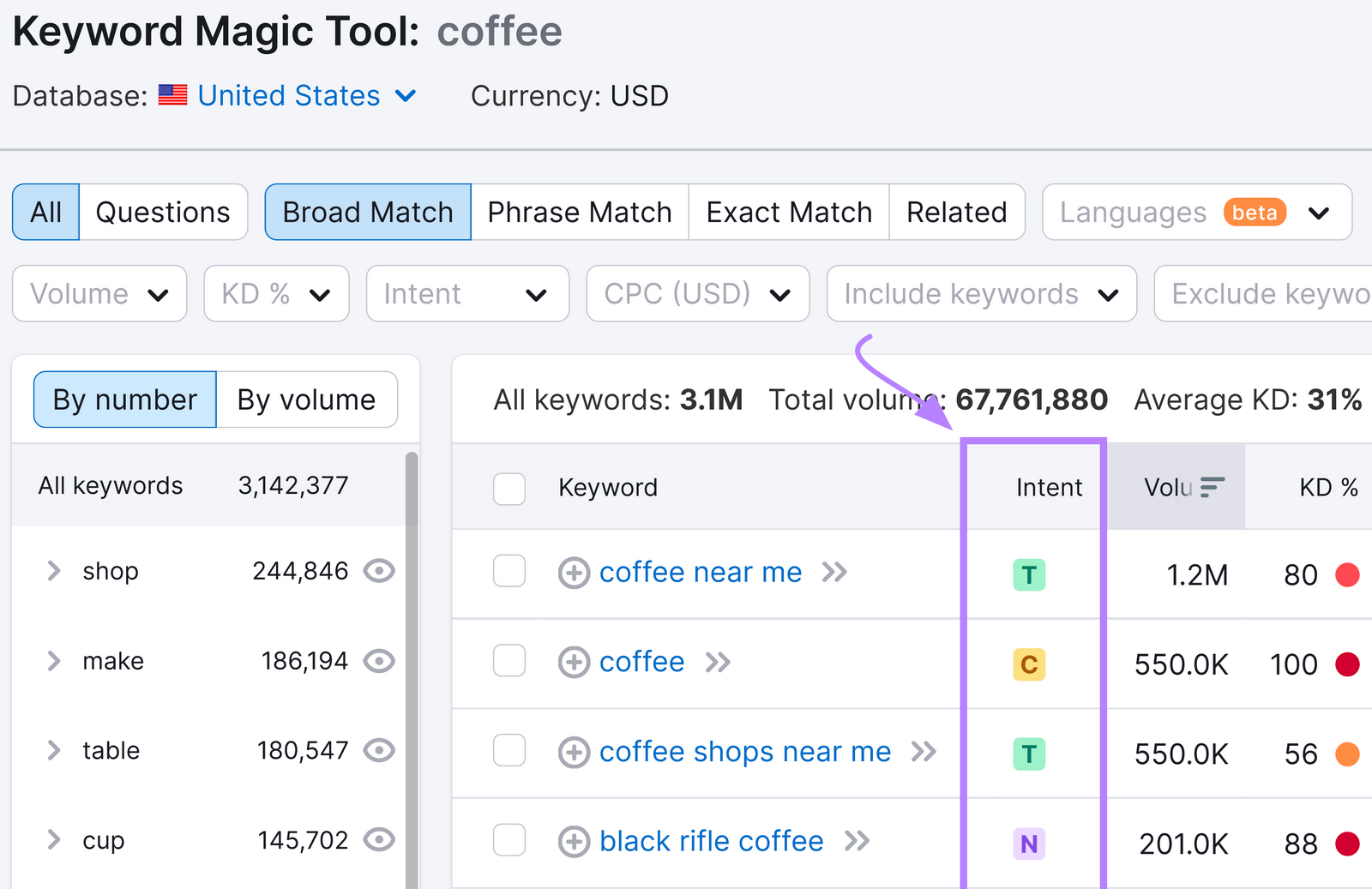
To assign an intent type to each keyword, Semrush looks into a few factors:
- SERP features in keyword search results (e.g., featured snippets)
- The presence of words in the keyword that indicate the user’s intention (e.g., “buy,” “address,” “how”)
- Whether the keyword is branded or not
How to Use Keyword Intent in Semrush
Here are three valuable ways to use keyword intent in Semrush:
- Check the Intent of Any Keyword (or List of Keywords)
- Analyze a Competitor’s Keyword Intent Profile
- Find Keywords by Intent
Keep reading for step-by-step instructions.
1. Check the Intent of Any Keyword (or List of Keywords)
Semrush’s Keyword Overview tool allows you to check the intent of up to 100 keywords at once.
Enter a keyword or multiple keywords separated by commas.
Then select your country and click “Search.”
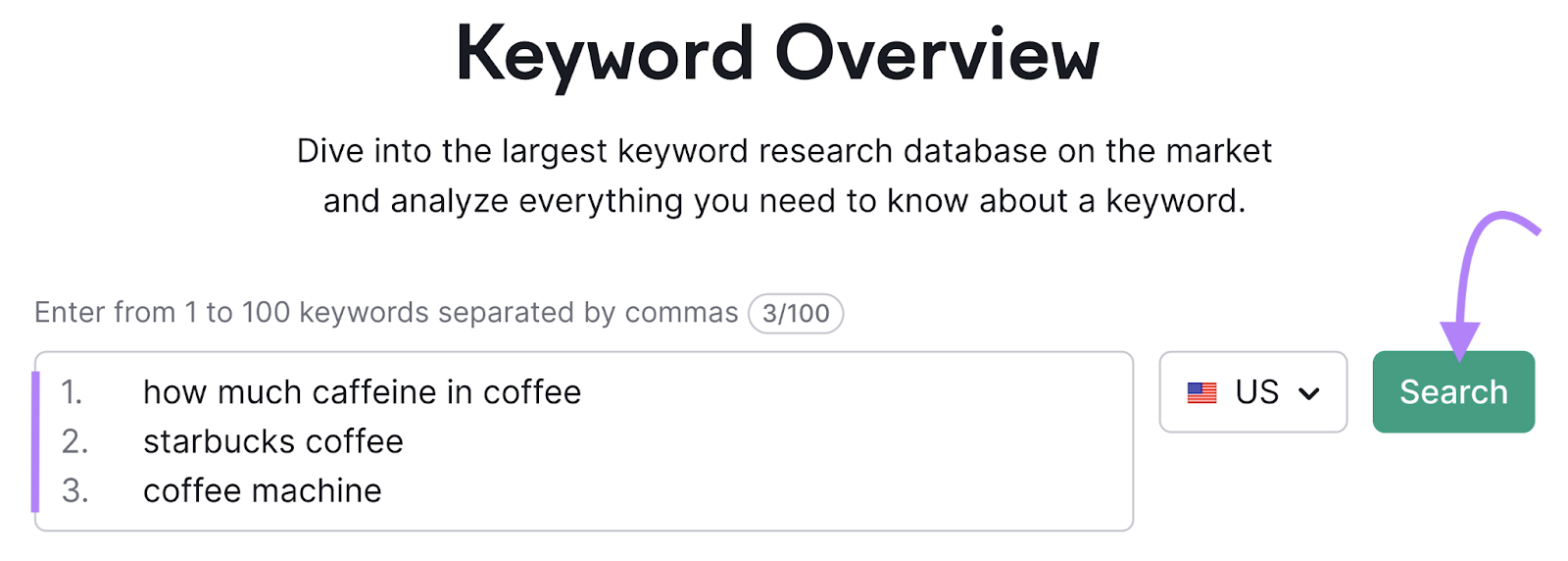
Look at the “Intent” column to see the types of keywords you’re dealing with. (Remember that some keywords may have mixed intent.)
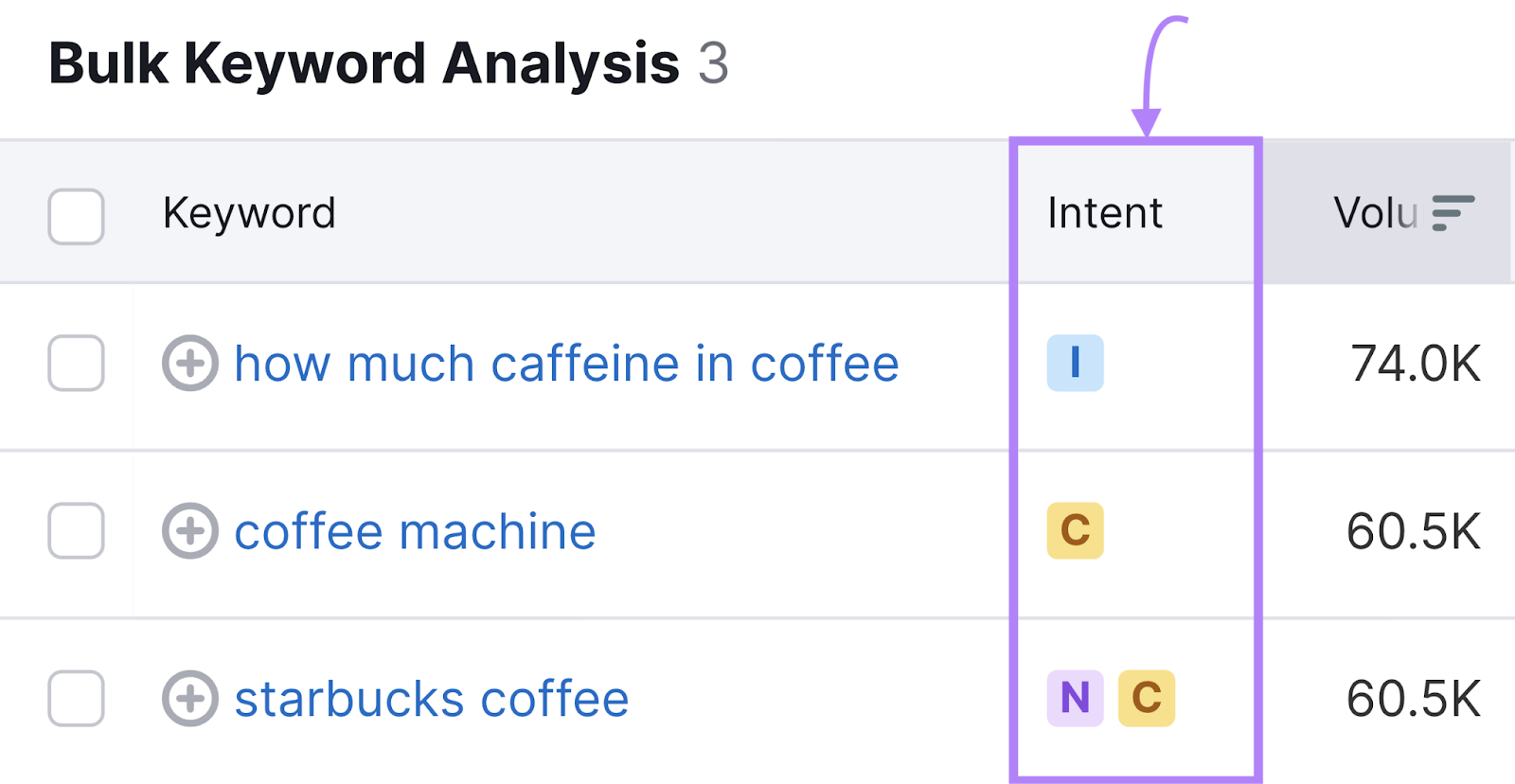
If you’re checking a single keyword, refer to the “Intent” box instead.
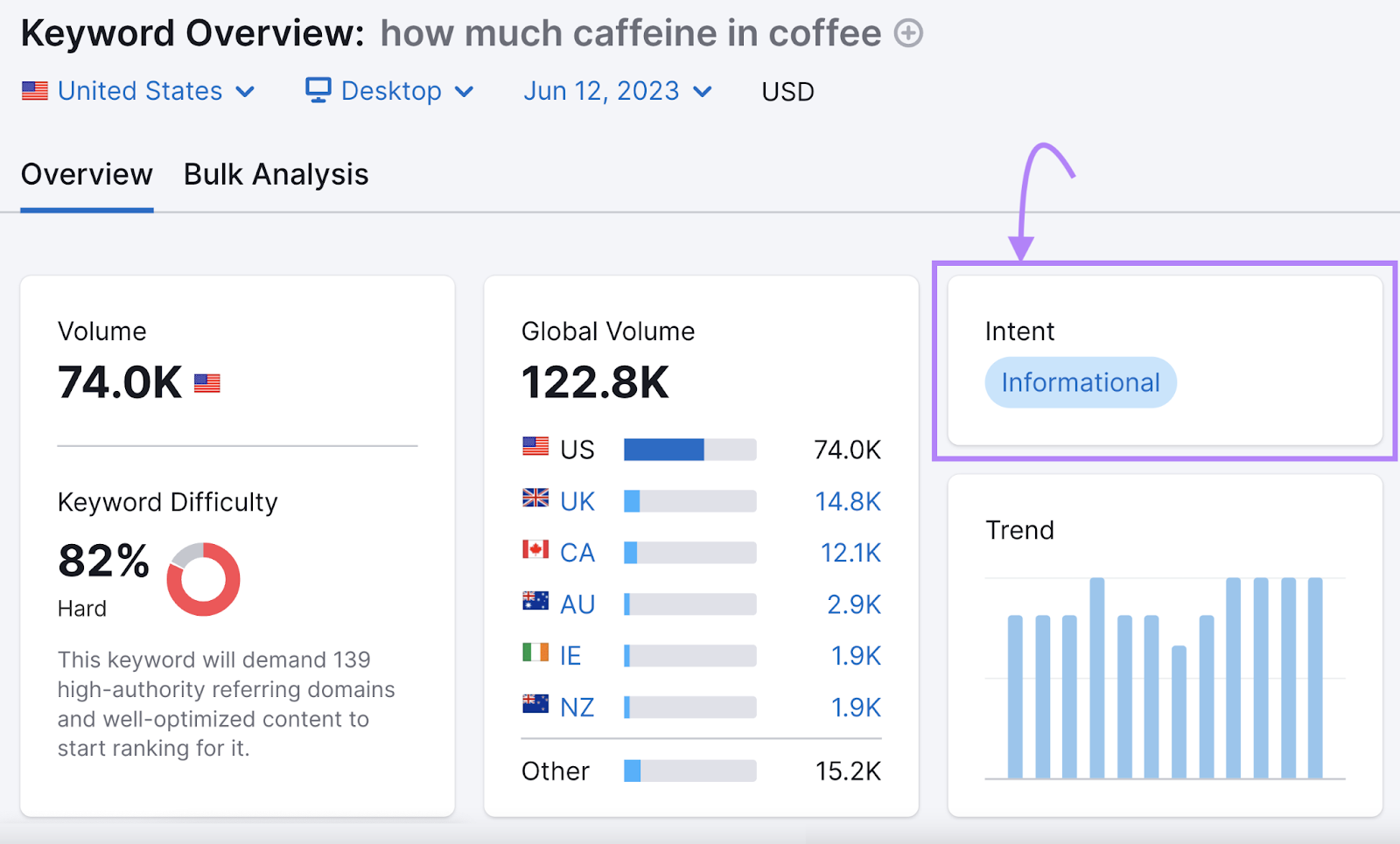
For a better understanding of search intent, analyze the SERP.
Just click the “View SERP” button or icon.
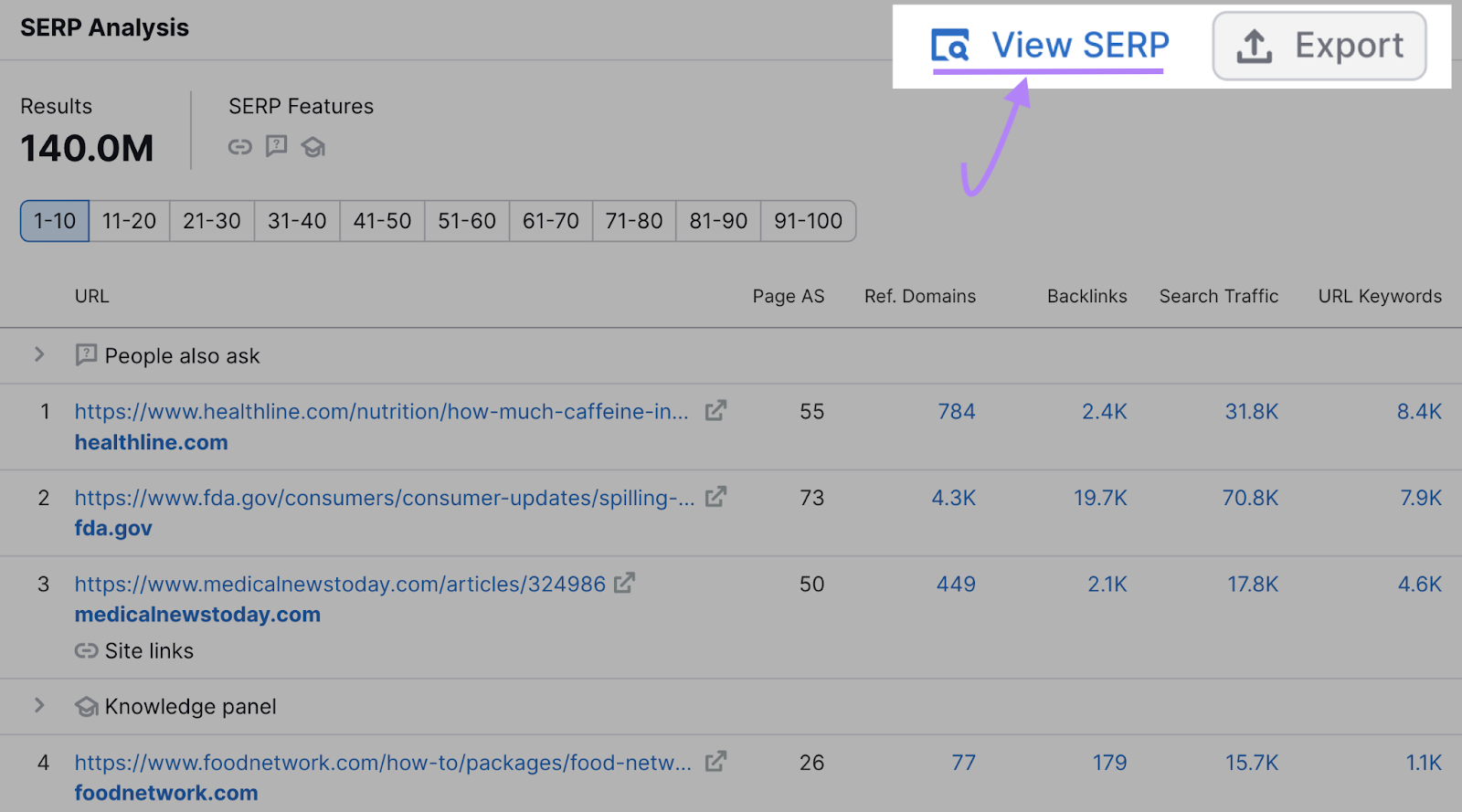
2. Analyze a Competitor’s Keyword Intent Profile
Find out what types of keywords your competitors rank for using Semrush’s Domain Overview tool.
Enter a competitor’s domain and choose your country.
Then click “Search.”

Hover on the colored bar for a breakdown of keywords by intent.
In this example, informational category keywords represent 49.2% of the domain’s rankings. And drive an estimated 7,402,725 organic visits per month.
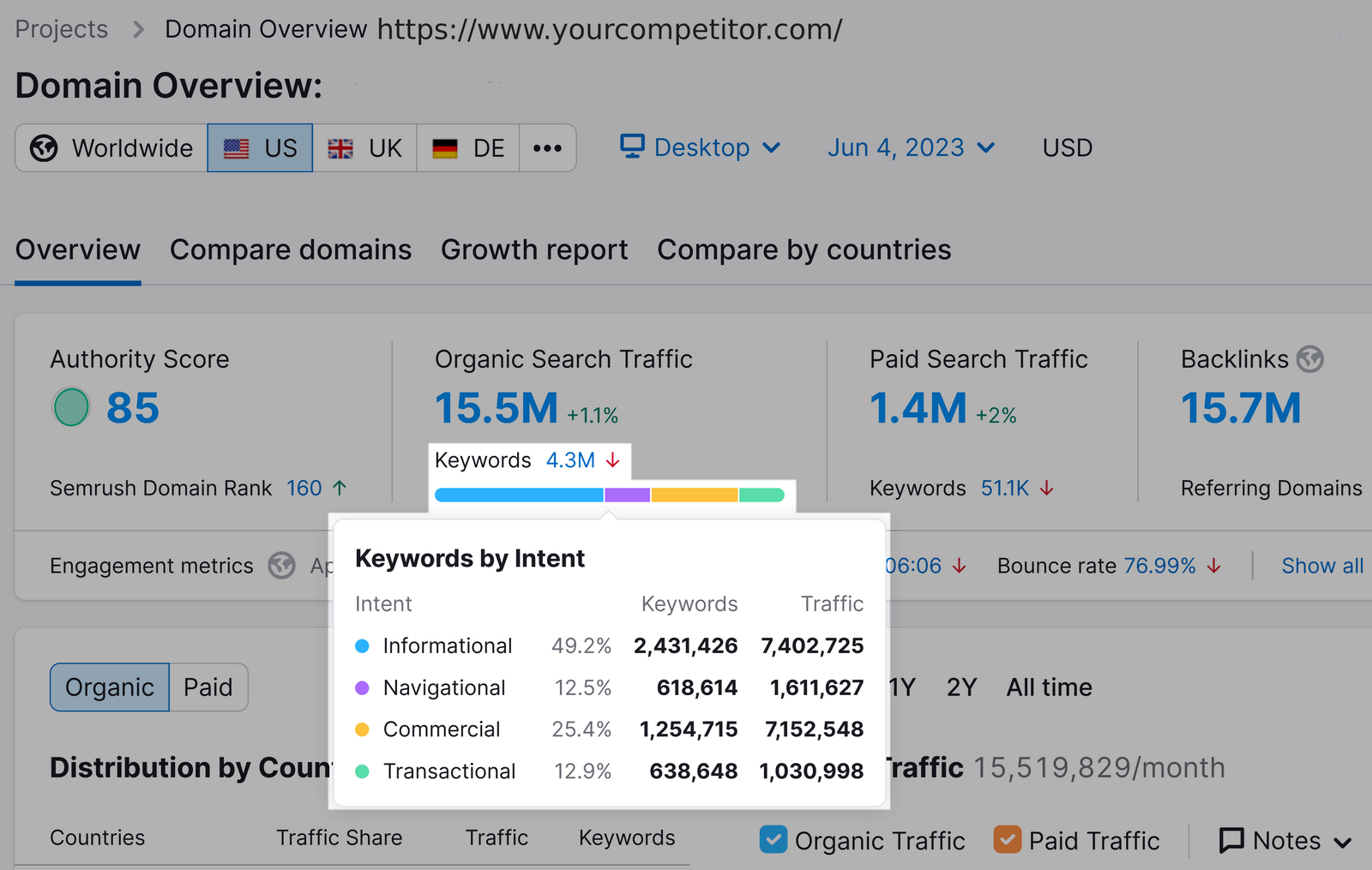
To see the individual keywords, click the blue number above the bar.
This takes you to the “Positions” report in Semrush’s Organic Research tool.
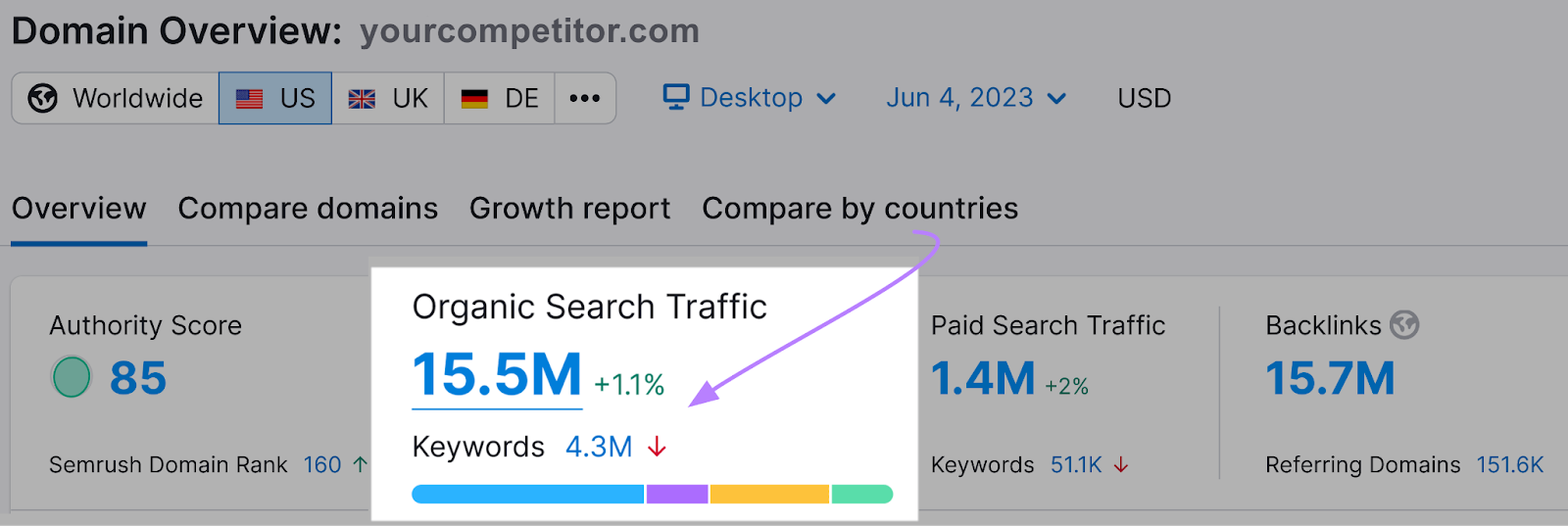
Here, you can see the type of search intent associated with each keyword. And other data, such as keyword volume (the average number of monthly searches in the country selected).
Use the “Intent” filter to focus on informational, navigational, commercial, and/or transactional keywords.
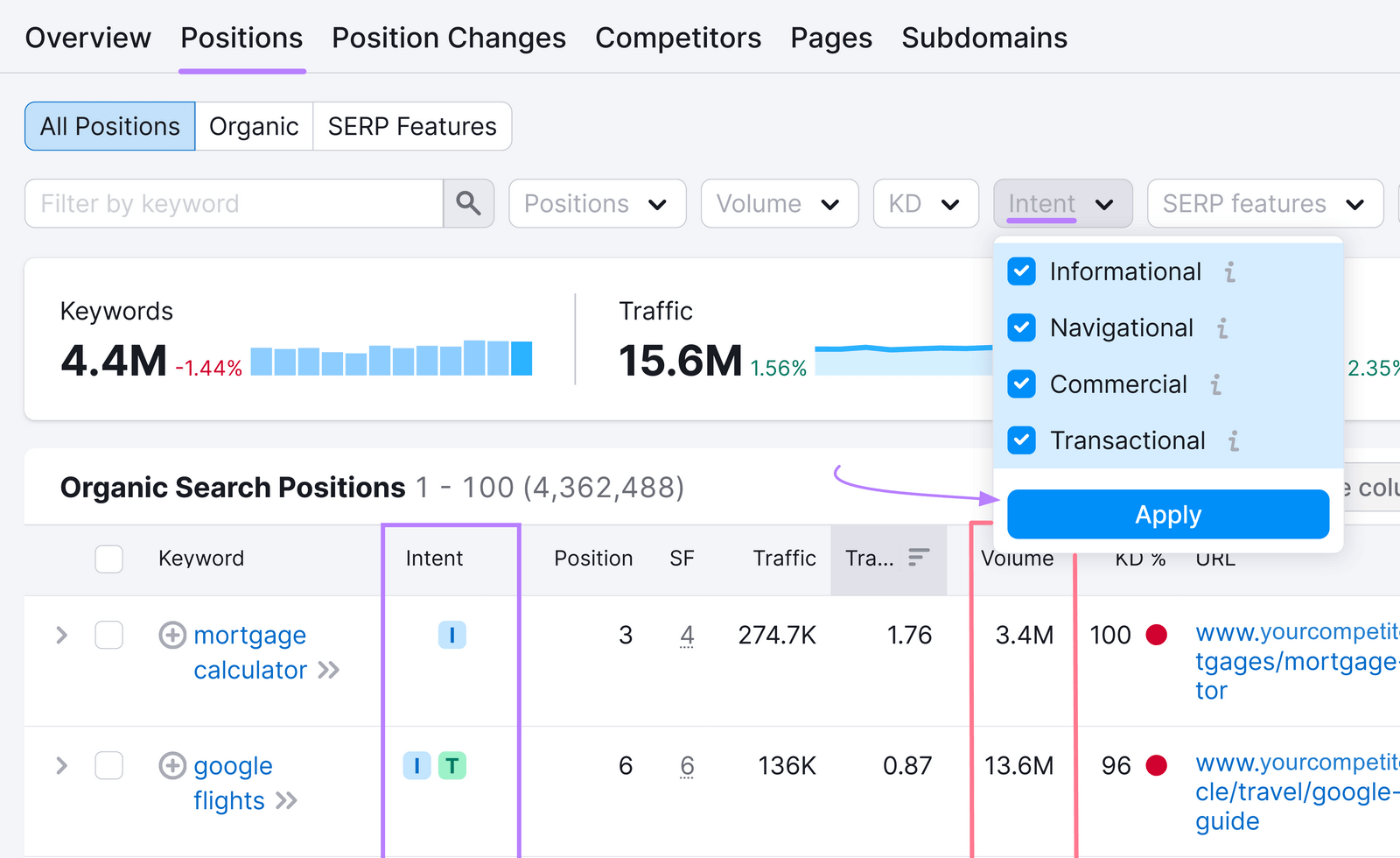
Next, inspect your competitor’s top pages in the “Pages” tab.
This shows you the types of keywords each URL ranks for. Starting with the pages that drive the most organic traffic (according to Semrush estimations).
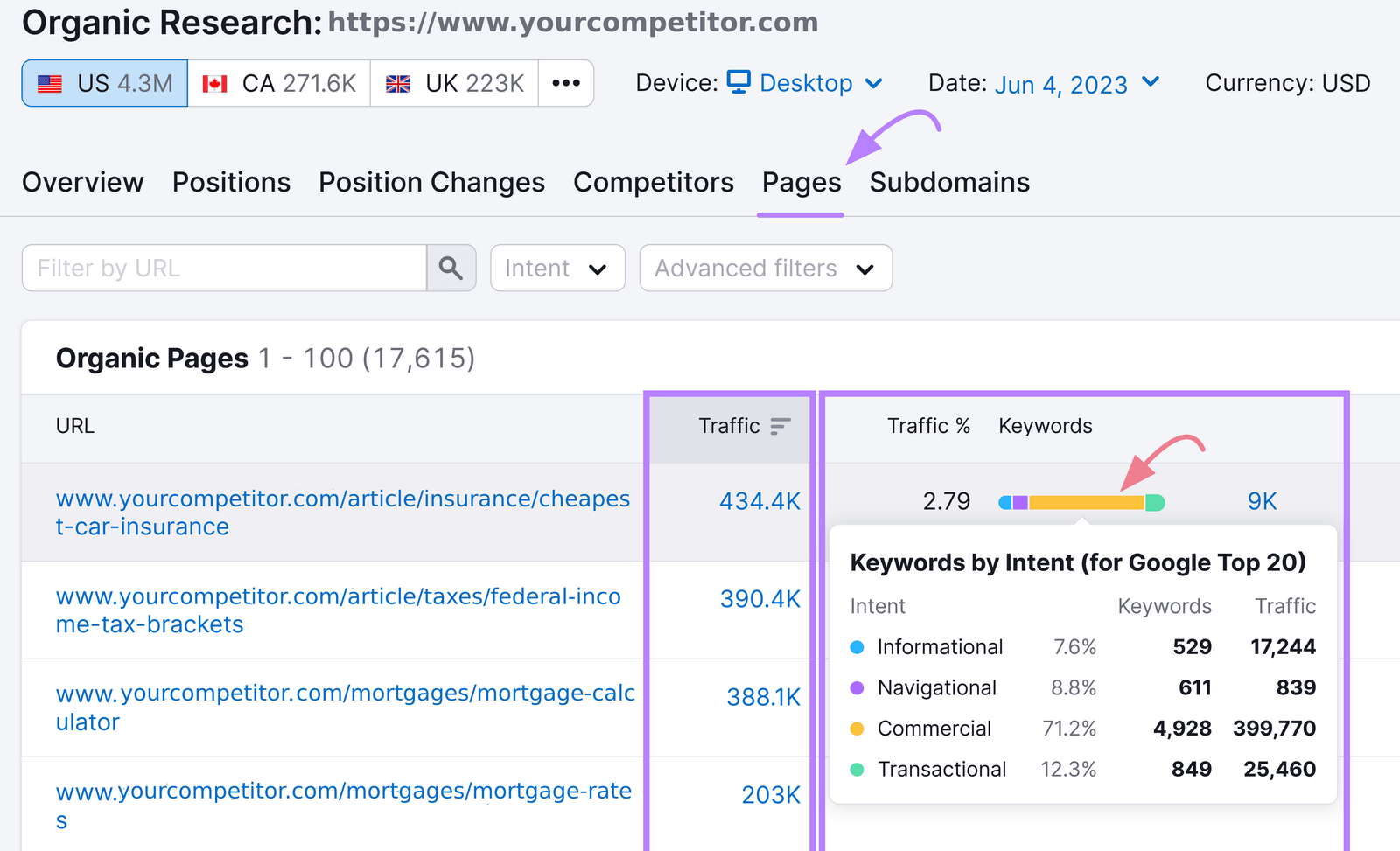
Which types of keywords (informational, navigational, commercial, and/or transactional) are bringing traffic to their most valuable pages?
Use this research as inspiration for your own content strategy.
3. Find Keywords by Intent
Semrush’s Keyword Magic Tool allows you to find keywords by intent. This helps you to identify new content and optimization opportunities.
To get started, enter a seed keyword related to your site.
Then choose your country and click “Search.”
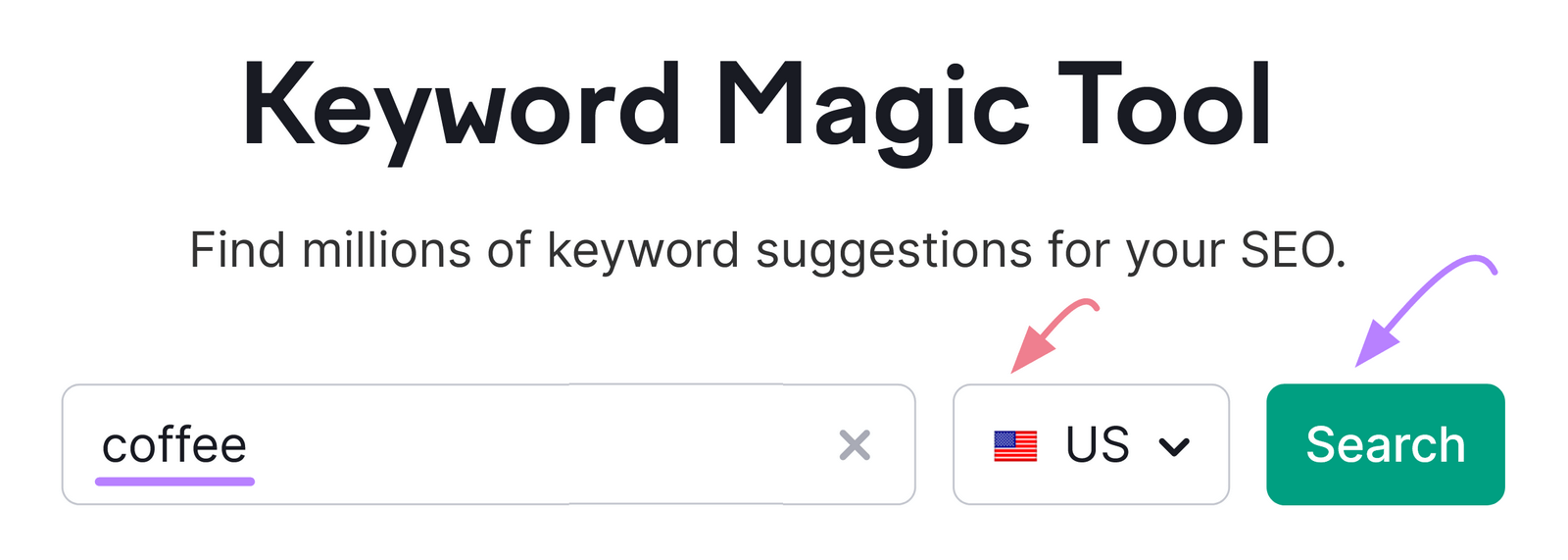
You’ll see keywords that include your seed keyword (or a close variation) along with various data.
Check the “Intent” column to see whether each query is informational, navigational, commercial, or transactional. Or a combination.
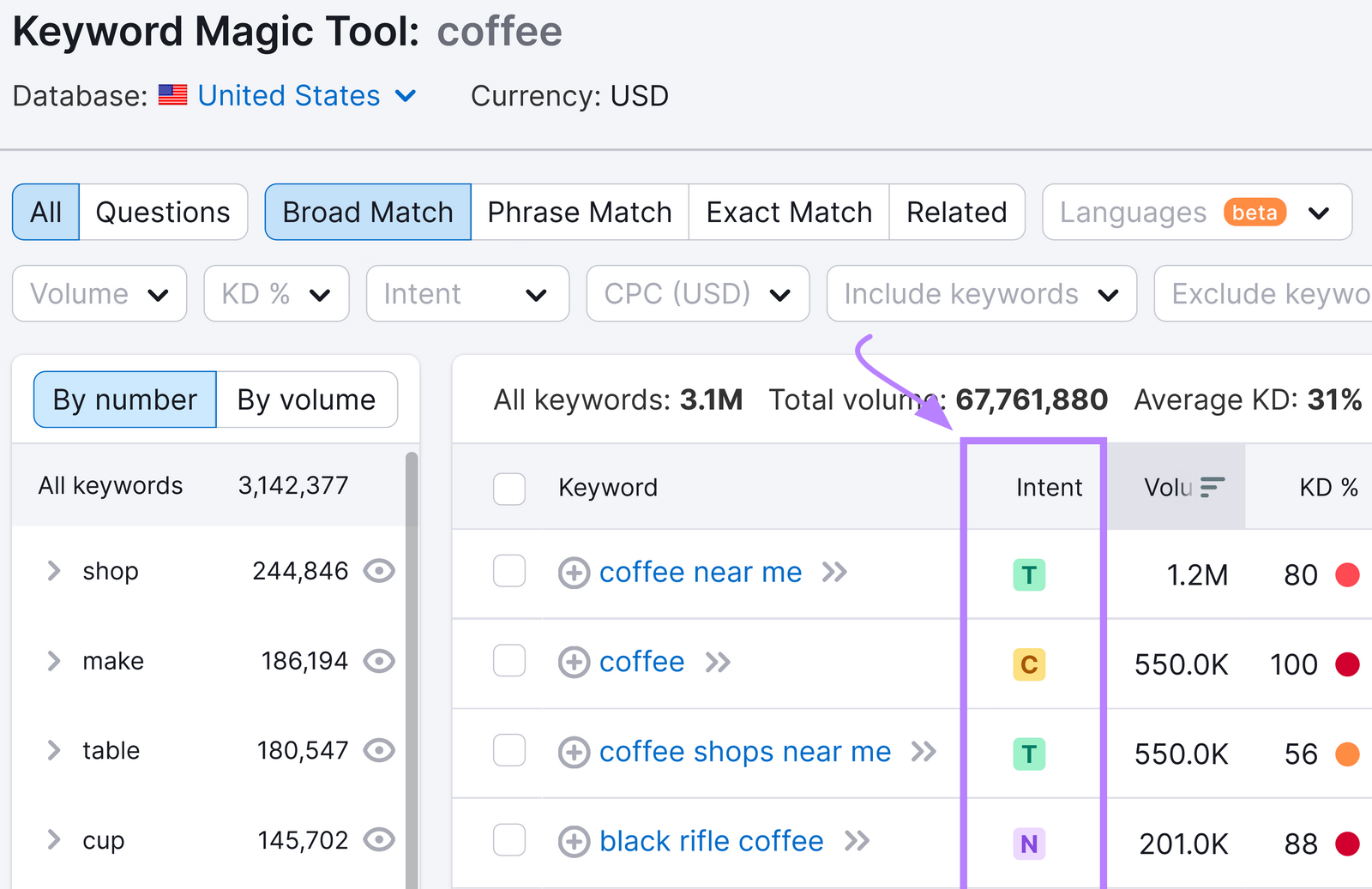
Transactional and commercial keywords are going to have the highest purchase intent, so these generally make better targets for paid advertising. Or for pages where your visitors can directly buy or take action on your site.
To see only these keywords, apply the relevant “Intent” keyword filter(s) to your table.
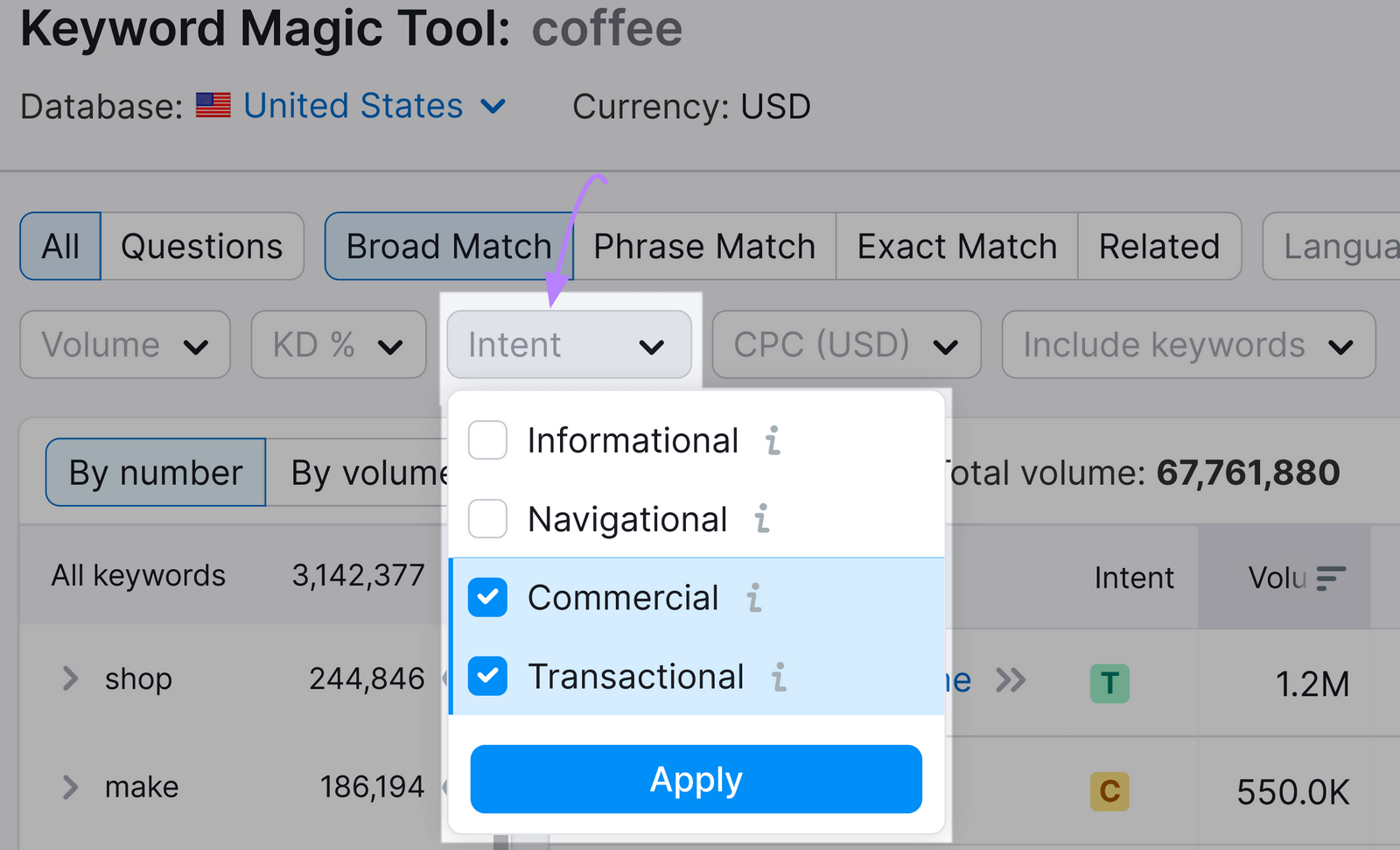
For more advice, check out our keyword research for SEO guide.
FAQs
How Do I Optimize for Different Types of Keywords?
Analyzing search intent helps you understand exactly what searchers want from every keyword. And create content that can rank highly.
But here are some general tips on optimizing your website for the different types of keywords:
| Keyword Type | Optimization Tips |
|
Informational |
Create quality content on relevant topics. Making sure to demonstrate Experience, Expertise, Authoritativeness, and Trustworthiness (E-E-A-T). |
|
Navigational |
Ensure your brand and company name are prominently displayed on your website. And your site structure and navigation menus are clear and easy to follow. |
|
Commercial |
Create product or service pages that include detailed information and high-quality images. And write the content to address searchers’ needs. |
|
Transactional |
Make it easy for users to take a specific action, such as making a purchase or filling out a contact form. |
For step-by-step advice on optimizing any page, check out our on-page SEO checklist.
Should I Target Every Type of Keyword?
Use a combination of all four types of keywords to improve your SEO by targeting different stages of the customer journey. But make sure to prioritize based on your business goals.
Tip: Analyze competitors’ keyword intent profiles to get an idea of the best ratio.
Here’s a customer journey example involving all keyword categories:
- Informational: Someone searches “what is a coffee dripper” and reads your blog post
- Commercial: They’re interested in buying, so they search “best coffee drippers” and read your comparison guide
- Transactional: They’re ready to buy, so they search “buy ceramic coffee dripper” and land on your product page
- Navigational: They liked buying from your brand, so they search “[BRAND] coffee filter paper” when they need a refill
Generally, transactional and commercial keywords are often best for PPC ad campaigns. If competitors bid on keywords including your brand name, you might want to focus on navigational search, too.
How Can I Track My Rankings for Different Keywords?
You can track your Google rankings for free through Google Search Console.
Click on “Search results” under “Performance.”

To focus on rankings, check the box next to “Average position” only.
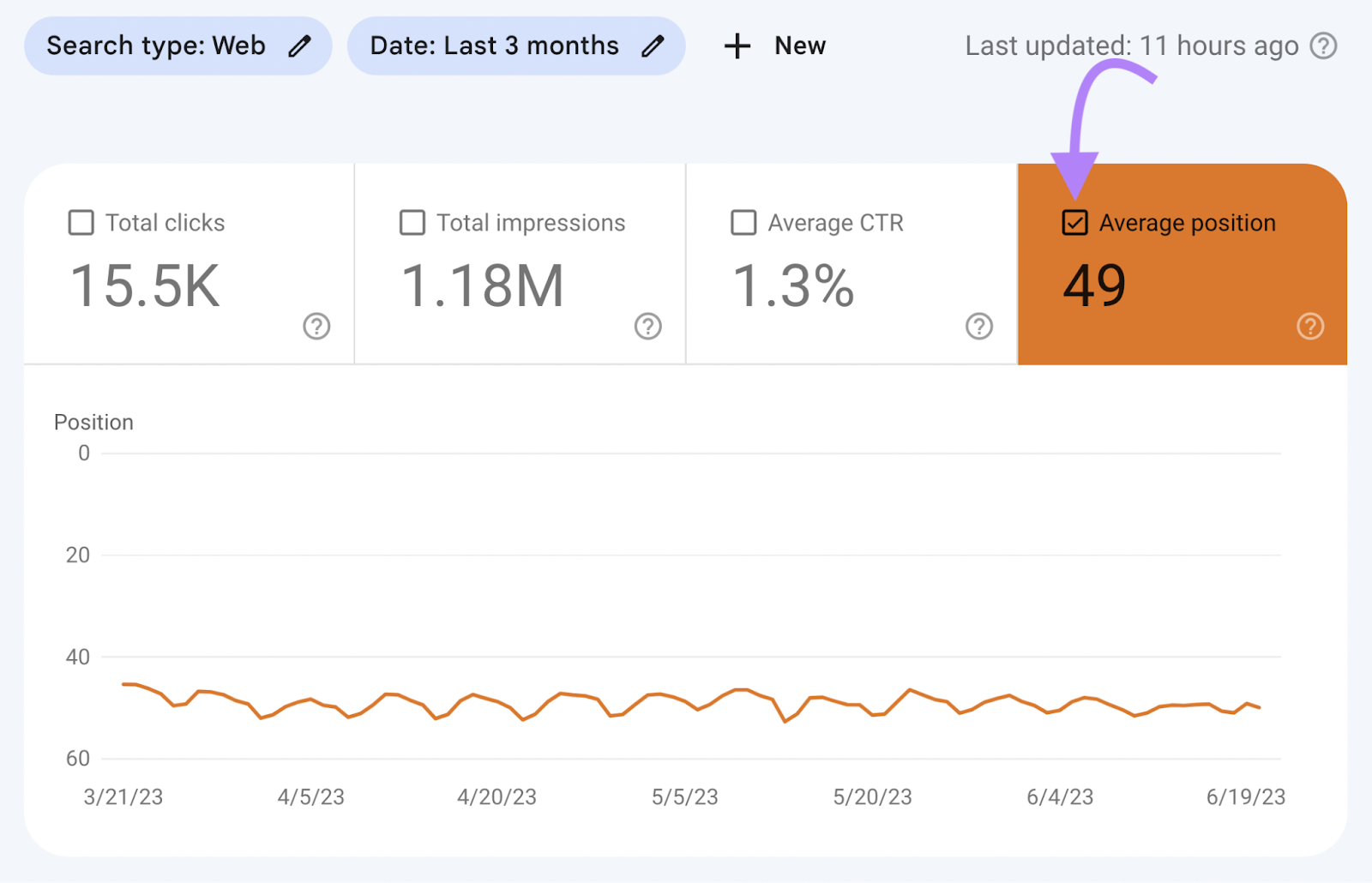
Now, scroll down to the “QUERIES” table.
You’ll see a list of keywords you’re ranking for. And position data for the selected time period.
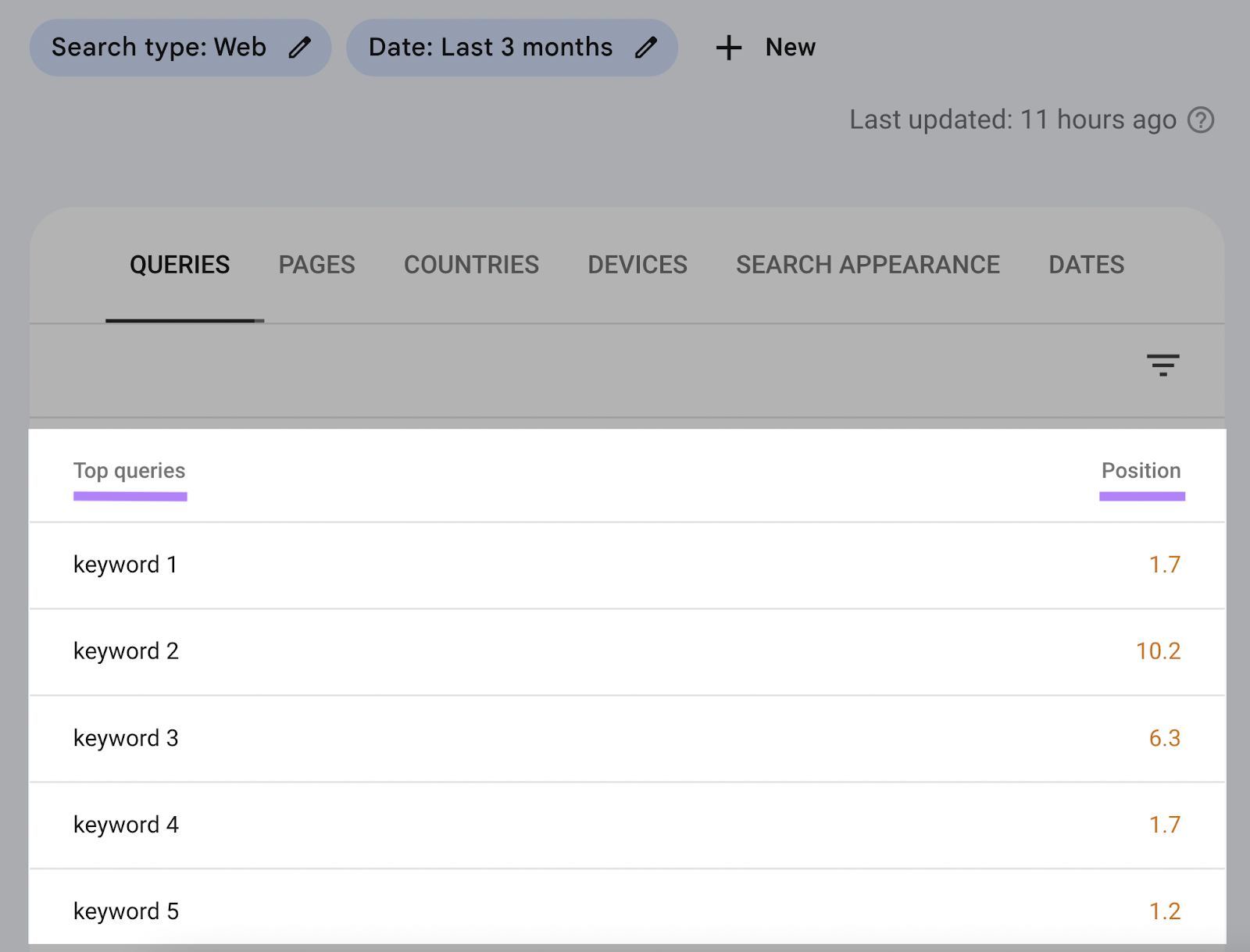
For more data and control, use Semrush’s Position Tracking tool.
It allows you to monitor the keywords, URLs, locations, and devices of your choice.
And provides valuable insights into SERP features.
After setting up, find your keyword rankings by going to the “Overview” tab. And scrolling down to the “Rankings Overview” table.
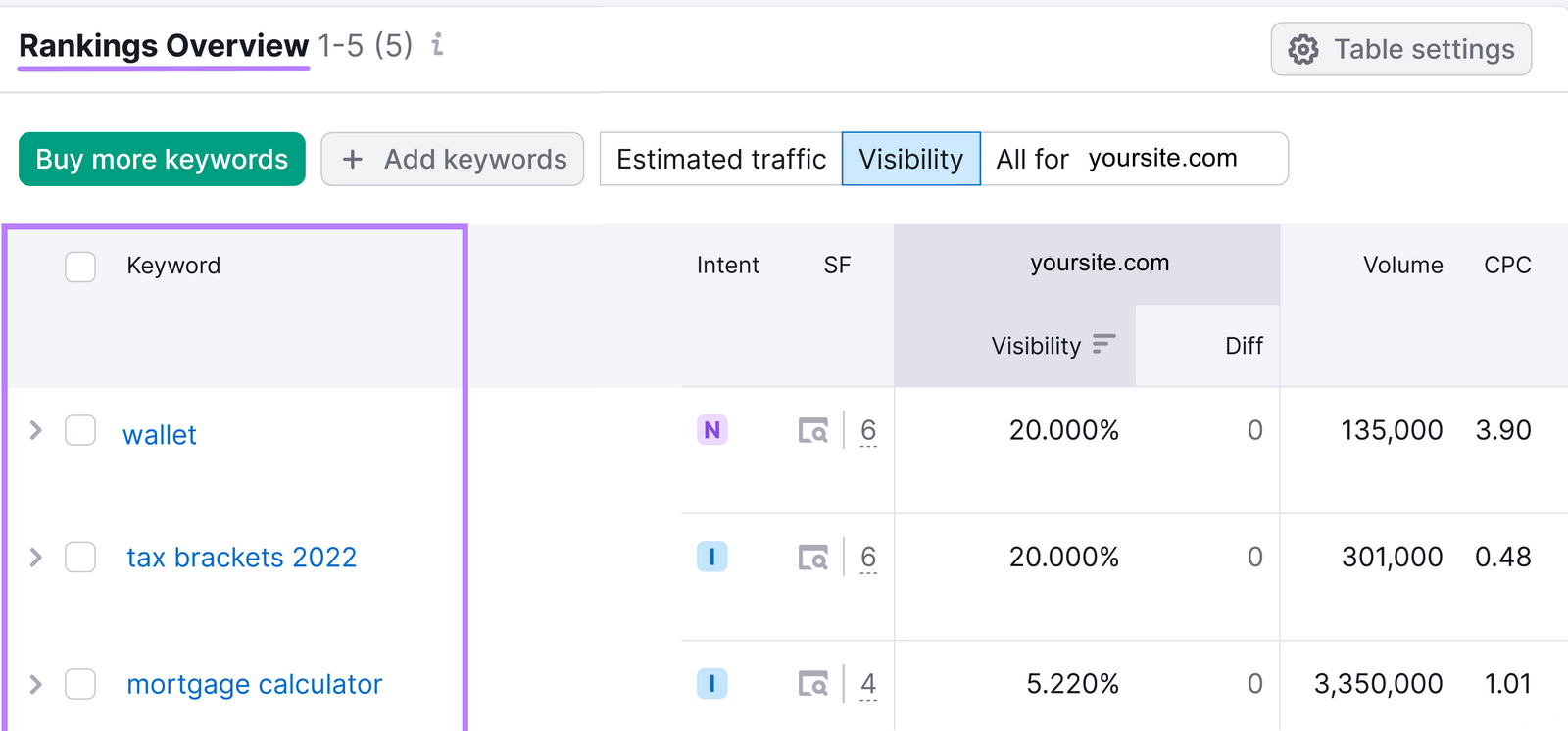
Filter by intent category to see how you’re performing for each type of keyword.
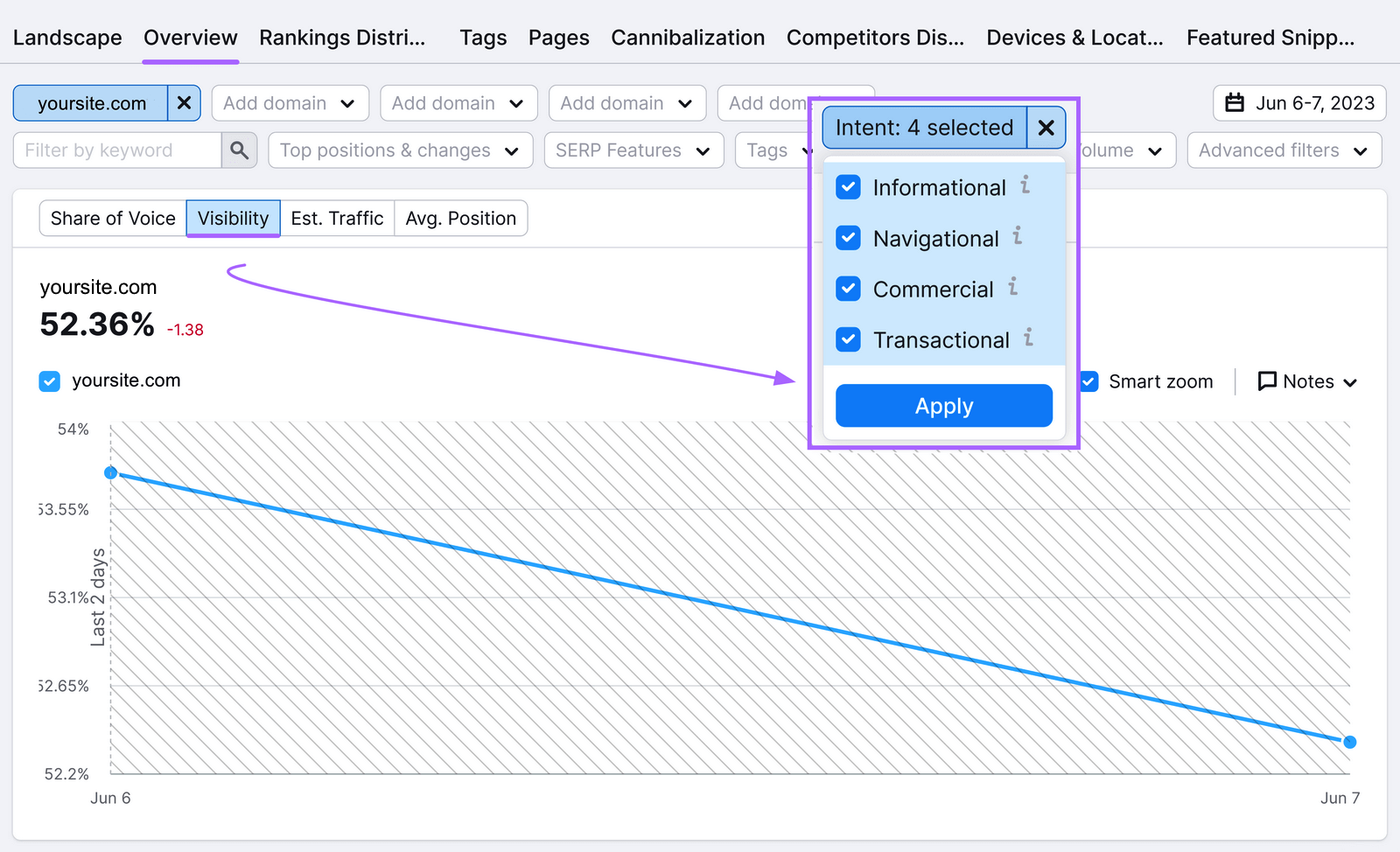
Source link : Semrush.com
